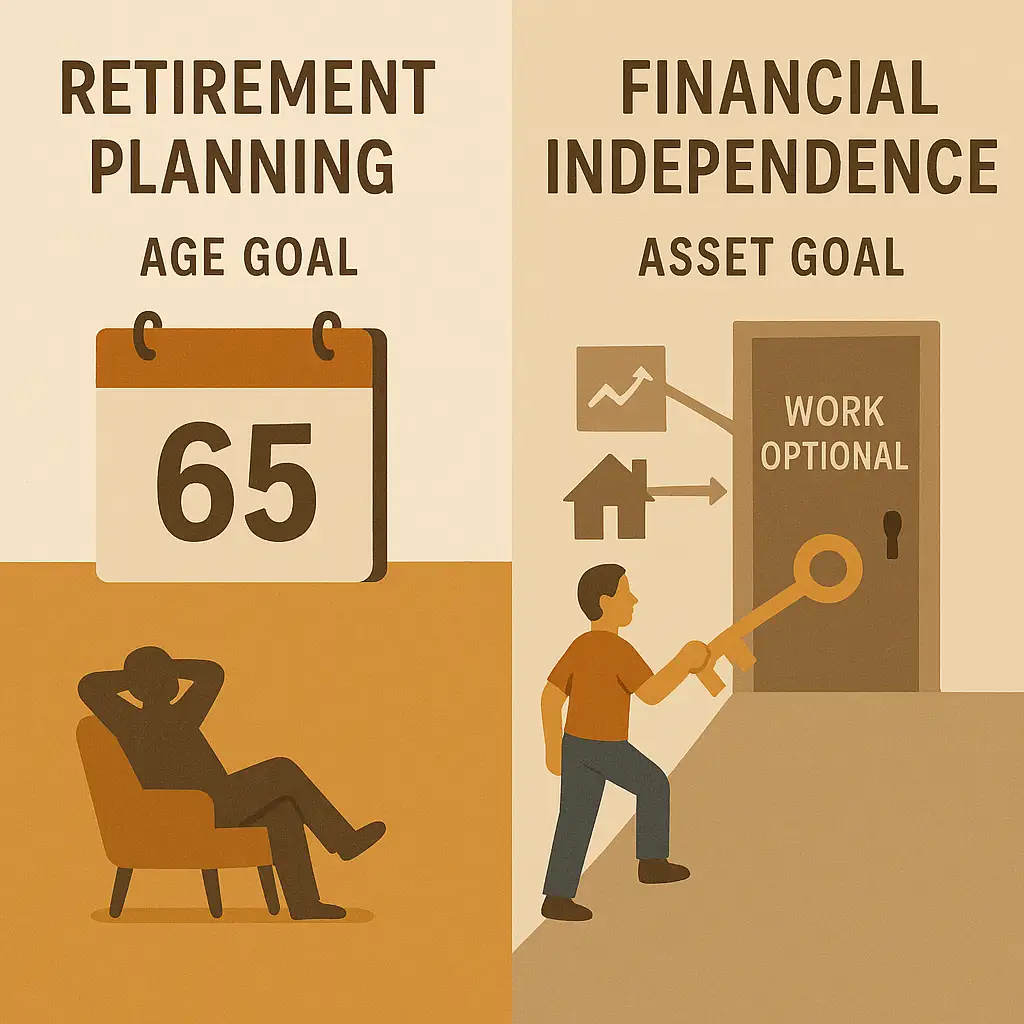Contents
Audio Podcast on Retirement Planning vs. Financial Independence
In discussions about long-term financial goals, you’ll often hear two terms used: “retirement planning” and “financial independence” (often shortened to FI). While they share similarities – both involve saving, investing, and planning for a future where work is optional – they represent distinct concepts and often lead to different strategies and timelines. Understanding the nuances between traditional retirement planning and the pursuit of financial independence is key to defining your financial goals (Link to 1.3 when created) accurately.
Traditional Retirement Planning: The Standard Path
- Goal: To accumulate enough savings to stop working full-time around a traditional retirement age (typically 60s) and maintain a desired standard of living for the rest of one’s life.
- Focus: Primarily age-driven. Planning revolves around having sufficient funds by age 65 or 67.
- Income Sources: Often relies on a combination of personal savings (401ks, IRAs), Social Security, and potentially pensions.
- Savings Rate: Typically recommends saving 10-15%+ of income over a long career (30-40+ years).
- Withdrawal Strategy: Often planned around rules like the 4% rule, designed to make funds last ~30 years post-retirement. (Link to 3.10 when created)
- Lifestyle: Assumes a transition from full-time work to full-time leisure/non-work activities around a specific age.
Financial Independence (FI): Work Becomes Optional
- Goal: To accumulate enough income-generating assets (investments, real estate, businesses) so that working a traditional job is no longer necessary to cover living expenses. The age at which this occurs is secondary.
- Focus: Asset-driven. Reaching FI happens when passive income from assets equals or exceeds expenses, regardless of age.
- Income Sources: Primarily relies on investment portfolio withdrawals, rental income, business income, etc. Social Security/pensions might be factored in later but aren’t the primary trigger.
- Savings Rate: Often requires significantly higher savings rates (can be 25%, 50%, or even 70%+) to accelerate asset accumulation.
- Withdrawal Strategy: Still relies on safe withdrawal rate principles, but may need to be more conservative due to potentially much longer time horizon if retiring early.
- Lifestyle: Achieving FI provides the option to stop working, reduce hours, change careers to something less lucrative but more passionate, or continue working by choice. It decouples income generation from traditional employment.

Key Differences Summarized
| Feature | Traditional Retirement Planning | Financial Independence (FI) |
| Primary Goal | Stop working at traditional age (60s) | Make work optional (any age) |
| Primary Driver | Age | Assets / Passive Income |
| Typical Timeline | 30-40+ year career | Can be much shorter (10-25 years) |
| Savings Rate | 10-15%+ | Often 25-70%+ |
| Focus After Goal | Full retirement/leisure | Choice (retire, change work, keep working) |
Overlap and Connection
Financial Independence is often a prerequisite for early retirement. The Financial Independence, Retire Early (FIRE) movement (Link to 5.1 when created) explicitly combines these concepts, using FI principles to enable retirement decades sooner than traditional timelines.
Even if you’re pursuing traditional retirement, understanding FI principles can be beneficial. Focusing on building assets that generate income provides a strong foundation, regardless of your target retirement age.
Conclusion
While both retirement planning and financial independence aim for a future where work isn’t mandatory for survival, they differ in focus (age vs. assets) and often strategy (savings rate, timeline). Traditional planning targets a specific age, while FI targets a specific level of passive income relative to expenses. Knowing the difference helps you clarify your own long-term objectives. Are you aiming for a traditional retirement timeline, or is the ultimate goal the option to leave traditional work sooner, powered by financial independence? Your answer will shape your savings and investment approach.

👋 Hi, I’m Jaiveer Hooda, the content creator behind Grow Your Money Smart!
I’m passionate about exploring the world of personal finance and sharing actionable insights to help you manage debt, plan for a secure retirement, and create passive income streams. 💡 My goal is to simplify complex financial topics and empower you to make smarter money decisions.
Let’s grow your wealth together, one smart move at a time! 💸
1 thought on “Retirement Planning vs. Financial Independence (FI): Understanding the Key Differences”